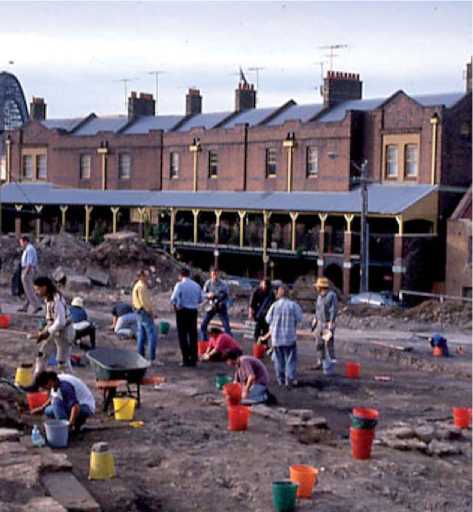London, as one might expect of the oldest city discussed here (it was founded by the Romans almost 2000 years ago), has the longest tradition of the ‘archaeology of the city’. Much of the city, including over a third of the City of London itself, was destroyed during World War II and had to be rebuilt. After the war, archaeologists felt an enormous urgency that excavations take place on a wide scale so that the city’s heritage would not either be destroyed by that redevelopment or rendered inaccessible for generations. But although they became seriously interested in the study of London in the late 1940s and 1950s, until relatively recently they concentrated on its earlier history, before post-Medieval times (see Europe, West: Historical Archaeology in Britain). The study of the archaeology of the modern, post-Medieval city, is a new field. There were several individual sites that proved to be potent catalysts to the study of London’s post-Medieval past. One was the Rose Theatre, where many of Shakespeare’s plays were first performed in the sixteenth century. This theater, built in 1587, was excavated in 1989 when an office tower was about to be built on the site. Its discovery and threatened destruction resulted in international public protest, with theater people particularly forming a concerned ‘descendant community’. The study of most of the provincial English cities has followed a similar trajectory: a long-term interest in the archaeology of the older history of these towns was only supplemented with an interest in the post-Medieval period during the last few decades. A good example is provided by the city of York, where the site of Jorvik, left by the Vikings, is one of the most famous sites in the world. But it is only recently that the archaeological study of the modern city has been undertaken.
The archaeological investigation of many of the cities of the former British colonies, on the other hand, has followed a different trajectory but with similar results. In most of these colonies, ‘cities’ only arrived with colonial settlement. The indigenous peoples of North America, Australia, and Southern Africa, for example, did not have cities at the time of the European arrivals. Modern cities only began there with the act of colonization, which occurred, first, in the US by the Spanish in La Florida in the sixteenth century, and then elsewhere by the English, Dutch, and French in the seventeenth and eighteenth centuries, well into the post-Medieval period. Therefore, any interest in the study of the cities in these outposts of empire by definition is confined to the post-Medieval period.
Prior to the mid-twentieth century, most of the excavations of modern cities in the United States were done by amateurs who worked on their own with little institutional support (see Americas, North: Historical Archaeology in the United States). In New York, for example, William Calver and Reginald Bolton conducted excavations of colonial and Revolutionary War sites particularly in upper Manhattan. Some of the earliest urban projects done by professionals took place in Philadelphia, with the National Parks Service excavations at Benjamin Franklin’s home in Franklin Court and several sites in Independence Park in the 1950s. These excavations were extremely important in that they proved to American archaeologists that remnants of the relatively recent historical past could survive in heavily urbanized areas. Since the 1980s there have been innumerable projects in many cities, and in some cases these projects have more recently been synthesized into books on the archaeological study of particular cities, including St. Augustine, FL; Philadelphia; PA; New York; Denver, CO; and London.
In Australia, the archaeological study of the city also began in the early 1980s with the excavation of such sites as the Hyde Park Barracks, First Government House, and the Royal Mint, all in Sydney. And

Figure 1 The excavation of the 19th-century Cumberland/Glou-cester Street Site in the Rocks, Sydney (Godden Mackay Pty Ltd).
In 1987-88, part of the working-class neighborhood of ‘little Lon’ (for Little Lonsdale Street) in Melbourne was excavated. But the excavation that brought Australia to the forefront of the study of the archaeology of the city was the excavation of the Rocks, the famous working-class neighborhood in Sydney (Figure 1) (see Oceania: Historical Archaeology in Australia). There have also been important excavations in Canada’s cities. Archaeology has proved extremely significant in the construction of national identity in the Francophone cities of Quebec and Montreal. There has also been archaeological study of Cape Town, South Africa.




 World History
World History









